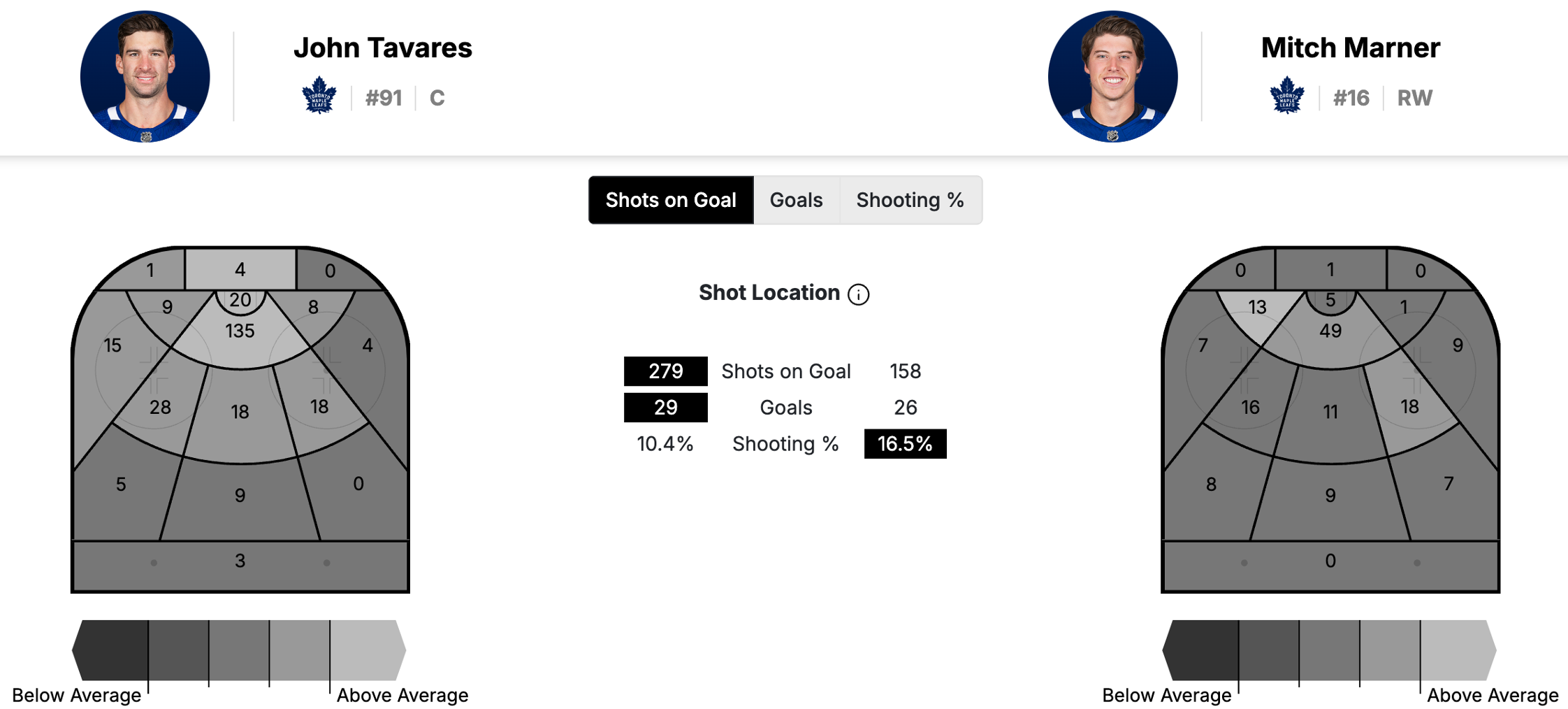This week marks the beginning of the ninth season of this Maple Leafs core featuring Auston Matthews, Mitch Marner and William Nylander.
Some things about this year's edition feel different, led by new coach Craig Berube, but ultimately, Leafs Nation is having the same debate since the beginning of this era: Do the Leafs have enough depth to have success into the post-season? With Marner and John Tavares approaching free agency and the city getting restless, the time has come to try something different.
The big dogs have made their money. Matthews, Nylander, Marner and Tavares are eating up 76 per cent of the cap space Toronto is spending on forwards (and 53 per cent of the total roster cap space) so the best course of action would be to split them across three lines and rely on the Core Four to pull the supporting cast up to their level.
To start the season, the Leafs should have Matthews, Marner and Nylander on separate lines.
So what should Toronto's lines look like when the season begins? Before we can do that, we need to understand how coaches build their lines, and how Berube tends to utilize his players.
HOW NHL COACHES BUILD LINE COMBINATIONS
Starting in the middle: Hockey is a centre-driven sport and the biggest stars tend to play down the middle (19 of the top 50 cap hits are centres). The core of a line's identity is defined by the player who is identified as the centre.
An advantage the Leafs could have in this area is that the Atlantic Division isn’t what it used to be down the middle. If the Leafs were to split Matthews, Marner and Nylander apart as centres, they'd have arguably the best centre depth of any Atlantic Division team, and would battle Jack Hughes-Nico Hischier-Erik Haula for the best in the conference. If I were the Leafs, I'd do with Tavares what Tampa Bay did with Steven Stamkos, and move him to the wing.
Creating pairs: Most lines are created around a pair of players. The centre may set the identity of a line, but a complementary winger is what pushes it to greatness. Look at how Brad Marchand exploded with Patrice Bergeron spring-boarding his career, or how Carter Verhaeghe has taken off while playing with Aleksander Barkov in Florida.
Now that Matthews, Nylander and Marner are approaching their late-20s, it’s time for them to help young players such as Matthew Knies, Nick Robertson, Easton Cowan or Fraser Minten to become the next generation of Leafs stars. Matthews proved last season he could revitalize Max Domi, and if the Leafs want to have success they have to build one or two new impact young players.
Line identity and purpose: When you have your centres set, you then need to figure out how you will utilize each of your four lines. Will you hard match, roll all four, or focus on zone starts? Who is going to play against the opponent’s top players? Who is going to take key face-offs, and how will you bump up your next shift coming out of special teams?
What's most interesting for this year's Leafs is how the two previous head coaches and the new guy in charge all have different philosophies in how they deploy their lines.
Babcock-Keefe-Berube comparisons: Mike Babcock was a more traditional coach with a tendency to focus on defining a line (scoring, defensive, checking) and matching them against an opponent, when possible, at home. For example, Nazem Kadri was often tasked with going head-to-head against the top players so that room could be opened up for the younger Matthews, which is partly what made Kadri's playoff suspensions all the more difficult.
Sheldon Keefe, hired in response to the Babcock era, was a “let the horses run” coach, meaning he put his best players on the ice in the best positions possible, and oftentimes together. This led to Matthews and Marner climbing from 18-19 minutes a game to 20-21 under Keefe. It also meant that there were a number of games where the entire Core Four was on two lines and, at times, when three of them were on the ice together.
With Berube behind the bench, you’ll see a style that falls somewhere in between Babcock and Keefe, according to coaches around the league. Berube tends to roll his lines -- in his time with the Blues, no forwards averaged over 20 minutes of ice time.
When St. Louis won they Stanley Cup in 2019, though, Berube did rely on a top line with Brayden Schenn and Vladimir Tarasenko, and had Ryan O’Reilly and David Perron eating up the hard matchups whenever possible. Don’t be surprised to see Berube keep to pairs throughout the season.
LINE COMBINATIONS TORONTO SHOULD START WITH
So what does it mean for the Leafs this season?
Given what we know about the new coach and the history of this group, I've got some ideas of what Toronto could do to revitalize the group, give new players a chance to rise, and maximize the lineup's potential.
We'll go through my four proposed lines one by one:
Line 1: Matthew Knies - Auston Matthews - Max Domi
Identity: Scoring
Let’s keep this simple. Matthews is a stud and newly minted as the captain, so it’s his ship now. He will score goals and have success no matter who is on the ice with him, but he also has lots of experience playing with both Domi and Knies. Together they should be able to play in any situation and have success.
Matthews has matured on and off the ice. He no longer needs a Marner or Nylander to help him drive play, or to get him the puck to score. Knies is ready to have a strong sophomore season and Domi can keep the flies off with his unique brand of skill and grit.
Line 2: John Tavares - Mitch Marner - Pontus Holmberg
Identity: Two-Way Elite
This is where we need to get creative and think a bit outside of the box.
There are two parts to a position in hockey. First is where you stand during the face-off. Last season Toronto had approximately 46 face-offs at 5-on-5 per game, and Tavares took about 17 of them. But after the face-off ends, that still leaves about 12 minutes of 5-on-5 ice time per game for Tavares, which is much more fluid and involves defending in the defensive zone, being available in the regroup, and creating offence in the offensive zone.
This is where I think Marner should take over the centre position and let his defensive dominance flourish. Tavares won nearly 60 per cent of his face-offs last season, while Marner has won just 45 per cent of every face-off he's taken in his NHL career (212). So, let the veteran stay on the draw, but in those other crucial minutes, Marner should be doing the heavy lifting. This is where the creativity comes in.
Especially when playing together, Tavares takes the role of big man making a living at the net. Marner, on the other hand, creates chances by feeding pucks into the slot (he’s top five in successful passes to that area) and tends to play higher in the zone. For comparison, Tavares had 155 shots from the lower and inner slot last season to Marner’s 54.
This diagram from NHL Edge shows both Tavares' and Marner's shot locations.

This shows why Tavares is effective playing at the offensive net, but doesn't answer why Marner should play low in the defensive zone.
For that let’s look at some numbers that show where the centre has to go in the defensive zone versus the winger.

As Toronto's lines are currently set up, when the puck goes from the offensive zone to the defensive zone, Marner’s route is 131 feet, compared to the 175 feet Tavares has to go from the net front to below the defensive goal line. So why don’t the Leafs lower the skating load for the soon-to-be 34-year-old Tavares, and let Marner take more responsibility defensively at 5-on-5?
Thanks to NHL Edge data, we can see that Matthews skates, on average, one mile more per 60 minutes of ice time than Tavares or Marner. Here are the skating distances for Tavares, Marner & Matthews from NHL Edge.


By building this unit around Marner, the identity of the line changes to two-way hockey. Marner and Matthews are the two strongest players the Leafs have defensively and can be better utilized spread out. For many years Marner has been the key piece to the Leafs' PK, and he has constantly proven an ability to play 200-foot hockey. It's time to let him shine defensively, take on more responsibility, and prove his value in a contract year.
Since Marner and Tavares are the pair that will drive this line, we need to find a good linemate to fit with them defensively who could play against the other team’s top players (we're using Pontus Holmberg, but could also consider Kampf, Jarnkrok or Dewar). Then, when the Lightning come to town, task this trio with shutting down Nikita Kucherov and let them prove they can make a difference while playing the hardest minutes at home.
Line 3: Easton Cowan - William Nylander - Nick Robertson
Identity: Skill in depth
This setup gives the Leafs an opportunity to have an effective third line that has evaded them for the past several years. To match Berube’s coaching style of spreading out the ice time, Toronto needs to take one of the Core Four and move them to the third line. My suggestion for this is to go with a true offensive scoring line of Nylander, Cowan and Robertson. Most teams only have one, or possibly two, strong two-way centres, and it becomes a complete matchup nightmare if you have a 90-point player on the third line.
This line would surely have its growing pains and would give up some goals every now and then. But it would also have more skill than the opponent's third line.
With Nylander joining the eight-figure salary club, Robertson coming to camp with a chip on his shoulder, and Cowan seeking to earn a spot on the team, you have a group of dynamic young players who have something to prove.
Play them against an opponent’s third or fourth line, start them in the offensive zone as often as you can and see if you can win the matchup with your third line, something the Leafs have so often struggled with in the past.
Honorable mention: Consider a Swedish connection line of Jarnkrok-Nylander-Holmberg.
Line 4: Bobby McMann - David Kampf - Calle Jarnkrok
Extras: Connor Dewar and Ryan Reaves
Identity: Utility
This line is a complete crapshoot on any night for the Leafs. If they need toughness against a team like the Rangers, Reaves goes in. If they need a penalty killer against the Lightning, Kampf slots in. Realistically this line will be a mashup of utility players who succeed at a specific part of the game. But you need to find space for these specialists somewhere in the lineup.
For the past five springs, a similar question has repeatedly come up: Can the Leafs win with four forwards eating up such a significant part of the salary cap? So far, the answer has been a resounding "no."
Now, with the end of this Leafs era potentially near, and a new coach with a new style behind the bench, it's a great time to give Matthews, Marner and Nylander complete ownership of their own lines, and turn up the heat from Day 1.




 3:27
3:27
